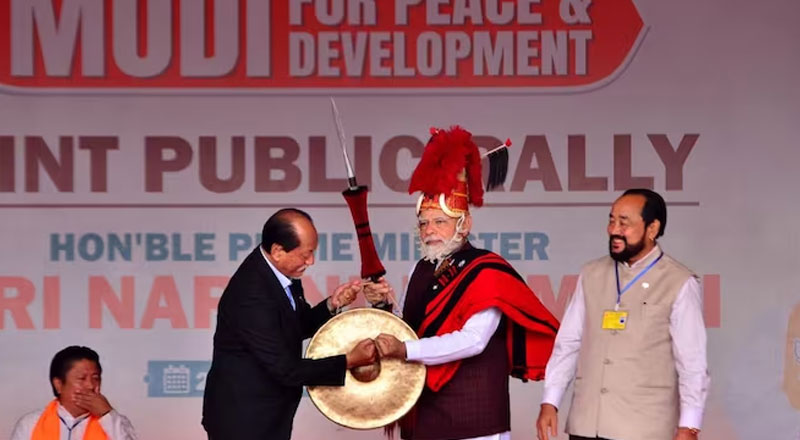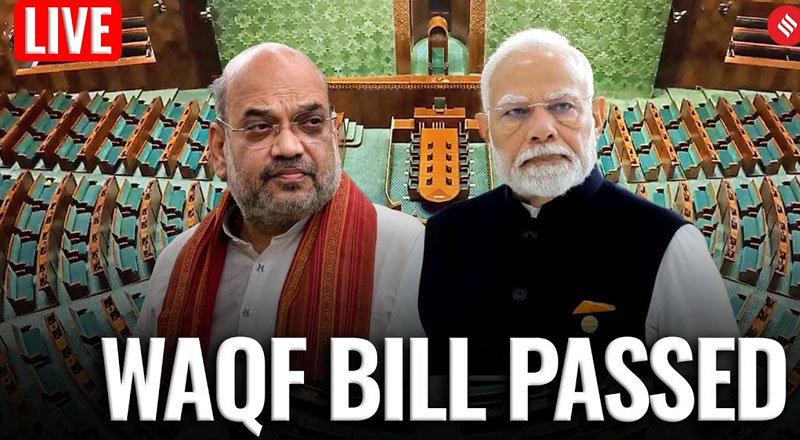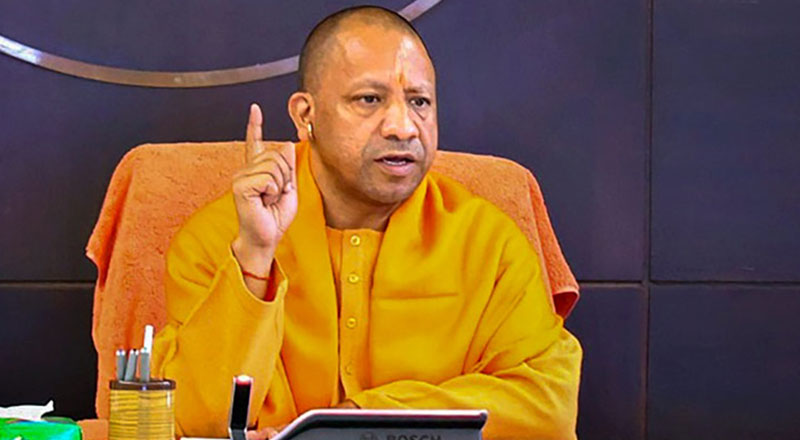Nagaland votes for its 60-member Assembly today. The BJP is contesting 20 seats. It had piggybacked CM Neiphiu Rio’s NDPP, but has been working on a plan to gain a solid foothold in Nagaland. For that, it is taking the route via Nagaland’s eastern part, but why?
After piggybacking Chief Minister Neiphiu Rio’s Nationalist Democratic Progressive Party (NDPP), the Bharatiya Janata Party (BJP) is looking to gain a solid foothold in Nagaland via its eastern part. Eastern Nagaland has some of the least developed parts of the state and has seen the demand for a separate state.
The voting for 60-member Nagaland Assembly is underway, and the fate of its candidates would be known on March 2.
The BJP has been running the government in Nagaland with the NDPP for five years, since the alliance won the polls in 2018.
But is there a reason why the BJP focuses more on the eastern part of Nagaland?
“The BJP is nurturing strongholds in eastern Nagaland, comprising six ‘backward’ districts and in Wokha district, which are relatively open to non-regional parties,” says Vikas Kumar, Associate Professor at Azim Premji University. Vikas is the author of ‘Waiting for a Christmas Gift’, a recent book on politics, elections and media in Nagaland.
“Eastern Nagas feel neglected under regional parties controlled by ‘advanced’ tribes. Among the ‘advanced’ tribes, the Lothas of Wokha feel (politically) disadvantaged too,” says Vikas Kumar.
Nagaland has 17 tribes and they have their own dialects and customs. There is no common Naga language and Nagamese, a pidgin, is used by the Naga people to communicate among themselves.
The six districts in eastern Nagaland have 20 Assembly seats, add to that Wokha district’s four, and the number goes up to 24.
When asked why eastern Nagaland is a priority area for the BJP, the party’s national spokesperson and Nagaland in-charge Nalin Kohli says, “Since eastern Nagaland is underdeveloped, it is on the government’s priority list in terms of developmental schemes and programmes.”
“The entire Northeast is a priority area for the BJP. State after state, under Prime Minister Narendra Modi’s ‘Act East’ policy and the positive agenda of Sabka Saath, Sabka Vikas, Sabka Vishwas & Sabka Prayas, is witnessing speedy development. In Nagaland, the eastern area of the state is relatively underdeveloped, hence, a need for a concerted effort for equitable development wherein eastern Nagaland should get some priority in schemes and initiatives,” Nalin Kohli adds.
The BJP government has adopted the ‘Act East’ formula and is giving special impetus to growth in the Northeast states.
Reminding that as per its alliance with the NDPP, the BJP was contesting only 20 out of the total 60 seats, Nalin Kohli pointed out that the party’s core presence was in eastern Nagaland, Mokokchung, Wokha, Zunheboto and Dimapur districts.
Nagaland comprises 16 districts and there are six districts in eastern Nagaland. The six districts of eastern Nagaland are Kiphire, Longleng, Mon, Noklak, Shamator and Tuensang.
Vikas Kumar says BJP has tried to anchor itself in the state from eastern Nagaland and Wokha. “The BJP first contested the Nagaland Assembly polls in 1987 with a candidate each in Mon and Wokha districts. Cut to 2003 and the BJP won seven seats, including four in eastern Nagaland and one in Wokha,” points out Vikas Kumar.
Since 2003, the BJP has won a seat in eastern Nagaland’s Mon in every election, adds Vikas Kumar. Of the 12 seats the BJP won in 2018, four were from eastern Nagaland.
“In 2018, the BJP’s elected representatives were from eastern Nagaland, Mokokchung, Wokha, Zunheboto, and Dimapur districts,” says Nalin Kohli. He adds that this time in 2023, the party is again contesting eight seats in eastern Nagaland, three in Wokha, three each in Zunheboto and Mokokchung, two seats in Dimapur district, and also the Southern Angami II seat.
The BJP had contested eight of the total 20 seats in eastern Nagaland in 2018, and this time also, the party is contesting the same number of seats. Even as the number of seats the BJP is contesting in eastern Nagaland hasn’t gone up, Nalin Kohli rejects any “conspiracy angle” of its senior ally NDPP trying to “contain the BJP”.
“Out of the 20 seats we contested in 2018, we won 12. We have repeated 11 sitting MLAs this time. This leaves us with only nine seats to consider, and the party is again contesting four seats that it had contested in the last election, which leaves us with only five fresh seats. So, it is not about the BJP being curtailed, it is the political reality of having a smaller kitty of 20 seats in an alliance,” says Nalin Kohli. “Also, we haven’t reduced our presence in eastern Nagaland,” he adds.
The BJP manifesto for the 2023 Assembly polls also had promises specific to the development of eastern Nagaland.
The BJP sees an opportunity in eastern Nagaland also because the tribes, who decide 20 of the state’s 60 seats, feel neglected within the state.
“Chief Minister Neiphiu Rio’s NDPP and the Naga People’s Front are identified with the Angamis. There is no other regional political party in the state. In its heyday, the Congress was identified with the Ao tribe. So, the tribes that are dissatisfied with their political condition have to turn to ‘outside’ parties (other than the Congress) while keeping one foot in the regional parties,” explains Vikas Kumar.
This eastern region of Nagaland is the most underdeveloped and the people have been alleging that they are discriminated against by people of the Kohima-Dimapur power centre. The area is inhabited predominantly by six Naga tribes.
Until the late 1940s, the eastern Naga tribal areas were mostly unadministered. It was only in 1974 that elections to the state Assembly were held in these districts.
The Eastern Nagaland People’s Organisation (ENPO), the apex council of the tribes of eastern Nagaland, had in August last year given the call for boycotting the 2023 Assembly polls over its demand for a separate state, Frontier Nagaland, comprising the six districts of eastern Nagaland. The ENPO relaxed the boycott call only recently.
“The government engaged with different groups from eastern Nagaland, including the ENPO. The representatives of organisations from eastern Nagaland had a series of talks over several weeks with officials of the Union home ministry and finally also met with Home Minister Amit Shah. Credit goes to Amit Shah and the home ministry for resolving the issue. As a result of the positive approach of the Modi government, the eastern Nagaland organisations decided to participate in the election process. Let’s not forget that the ENPO and other organisations had originally called to boycott the 2023 Assembly polls,” says Nalin Kohli.
Home Minister Amit Shah addressed two election rallies in the eastern Nagalnad towns of Mon and Tuensang.
“Amit Shah is the first home minister in the history of the country to stay overnight in eastern Nagaland in Mon town. He spent two days in eastern Nagaland to assure people that the BJP’s priority is development,” says Nalin Kohli. “Home Minister Amit Shah got a rousing welcome in both Mon and Tuensang with about 8,000-10,000 people attending his rallies. This is very impressive for constituencies where the overall number of voters ranges between 18,000 and 24,000 votes, ” he adds.
Vikas Kumar says the abysmal share in public sector jobs and the perception of a severe development deficit are driving the statehood demand from the eastern districts. “The eastern tribes blame Nagaland’s educationally advanced tribes for the poor quality and limited reach of public infrastructure and services in their districts,” he adds.
How will the NDPP-BJP tackle the demand for a separate state by the ENPO?
“The matter has broadly been discussed and decided. It has not been made public due to the Model Code of Conduct being in force. Whatever has been decided and agreed to between the parties concerned, including the ENPO, is regarding meeting their developmental and other aspirations within the state of Nagaland itself,” says Nalin Kohli.
HOW IS THE NDPP-BJP COMBINE PLACED?
Neiphiu Rio split from the Naga People’s Front (NPF) just before the elections in 2018 and formed the NDPP. In the last polls too, the NDPP and the BJP went ahead with a 40:20 seat-sharing formula. The BJP won 12 of the 20 seats it contested, while Neiphiu Rio’s NDPP won 18 of the 40 seats. The Congress managed just six seats in the 2018 polls and the NPF won 26 seats.
Of the 12 seats the BJP won in 2018, four were from eastern Nagaland. It had contested nine of the 20 seats in that region.
Undoubtedly, the BJP has nurtured its Nagaland ambition through its eastern part and whether it turns out to be a key player in the northeastern state would depend on how that plan works.





